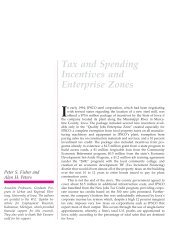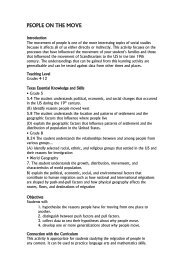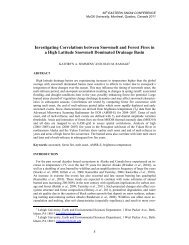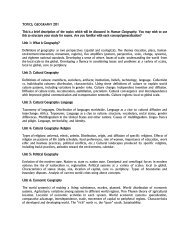Texas Social Studies Framework - Department of Geography ...
Texas Social Studies Framework - Department of Geography ...
Texas Social Studies Framework - Department of Geography ...
You also want an ePaper? Increase the reach of your titles
YUMPU automatically turns print PDFs into web optimized ePapers that Google loves.
86<br />
86<br />
ORGANIZATIONS AND AGENCIES:<br />
INFORMAL EDUCATORS<br />
Students do not leave education behind when they exit<br />
the classroom. Many institutions <strong>of</strong>fer educational<br />
programs that provide learning opportunities outside the<br />
school classroom setting. Students can participate in<br />
these <strong>of</strong>ferings virtually via the Internet or literally by<br />
visiting the site with their class or their family or by<br />
reading a pamphlet or other educational material produced<br />
by the agency.<br />
These are informal educational experiences. The institutions<br />
are not mandated by law to provide resources that<br />
help teach the social studies. They do so as a public<br />
service. School groups, children, and their families who<br />
partake <strong>of</strong> these resources do so voluntarily. The experiences<br />
are <strong>of</strong>ten self-directed. With the exception <strong>of</strong> the<br />
Internet and public agencies which <strong>of</strong>fer free access,<br />
many organizations and agencies charge admission for<br />
viewing exhibits or a fee for materials. The information<br />
is detailed and may take some time to understand, yet the<br />
return is worth the effort. The knowledge and unique<br />
experiences that informal educators provide can make a<br />
significant contribution to social studies education in<br />
<strong>Texas</strong>.<br />
Many agencies and organizations <strong>of</strong>fer opportunities for<br />
informal education and <strong>of</strong>fer services that support several<br />
social studies disciplines and themes. Organizations and<br />
agencies include museums and historic sites, parks,<br />
nature centers, chambers <strong>of</strong> commerce, county courthouses,<br />
police departments, and research consortiums.<br />
Representatives from these organizations or individuals<br />
such as the meteorologist with the local television<br />
station, the archivist at the public library, or the fire<br />
marshal regularly provide presentations and information<br />
to school groups or interested citizens.<br />
The informal educators can contribute to social studies<br />
education if teachers, administrators, and parents believe<br />
that the programs can support instruction based on the<br />
TEKS for <strong>Social</strong> <strong>Studies</strong>. To ensure this, the players must<br />
cooperate.<br />
• Teachers or local district administrators can work<br />
with informal educators to provide more directed<br />
experiences that satisfy TEKS requirements.<br />
• Informal educators can devise experiences and<br />
materials that encourage interaction between<br />
Chapter 8: Implementing the TEKS: Other Players<br />
children and their parents or between children in<br />
groups.<br />
• The informal experiences encourage interaction<br />
and exchange that crosses cultural, educational,<br />
and economic divides. These exchanges occur in<br />
a variety <strong>of</strong> locations.<br />
Ways Museums and Historic Sites Can Be Used to<br />
Support <strong>Social</strong> <strong>Studies</strong><br />
Following are ten things that every administrator and<br />
social studies educator ought to know about using<br />
museums and historic sites to make the most <strong>of</strong> a<br />
valuable resource:<br />
1) Museums are a significant teaching resource.<br />
2) Museums and historic sites inspire students.<br />
3) There are many types <strong>of</strong> museums.<br />
4) Museums <strong>of</strong>fer students informal opportunities<br />
to learn and can help teachers design rich<br />
experiences for students.<br />
5) Museums and historic sites have good curriculum<br />
support materials.<br />
6) Virtual trips to museums and historic sites are<br />
almost as good as real trips.<br />
7) A successful museum trip involves the “Three<br />
P’s”: preparation, participation, and post-visit<br />
reflection.<br />
8) Teachers and students can make a museum <strong>of</strong><br />
their own in the classroom.<br />
9) Museum educators and curators are both<br />
resources and role models.<br />
10) The United States has many excellent museums<br />
with unlimited learning opportunities.<br />
1) Museums are a significant teaching resource.<br />
Many schoolchildren in the United States visit a museum<br />
each year. The more than 8,200 museums and 15,000<br />
historic sites in the nation provide plenty <strong>of</strong> choices.<br />
Visiting these institutions, however, poses challenges for<br />
many teachers. The effort is worth the investment<br />
because the materials preserved and exhibited provide<br />
information that words alone cannot convey. The artifacts<br />
and ideas that museums and historic sites collect,<br />
preserve, and present constitute powerful and memorable<br />
learning experiences for students. The process involves<br />
three stages: preparation, participation, and post-visit<br />
reflection. Getting students ready for the activity, using<br />
the time spent in the museum or site wisely, and follow-
















